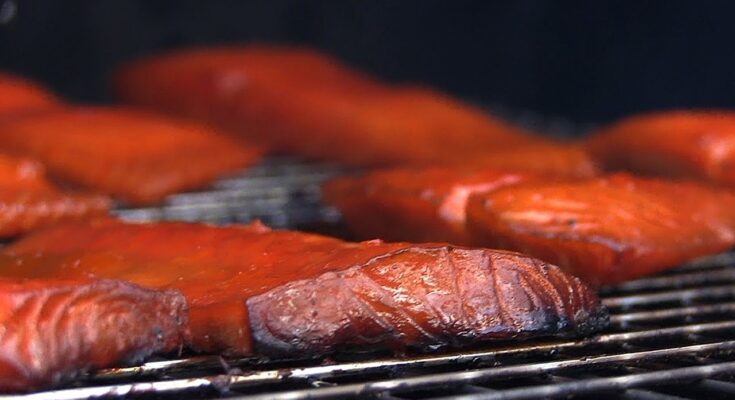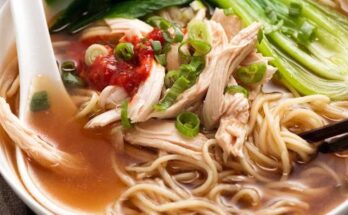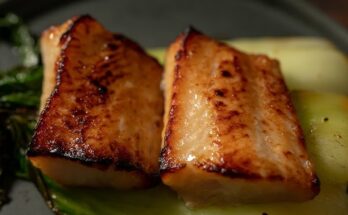Smoked Salmon Brine Recipe: Smoked salmon is one of those foods that feels fancy yet comforting. It’s rich, flavorful, and surprisingly simple to make at home—if you know the secret: a perfect brine. Brining is more than just a step; it’s the foundation for achieving that silky texture and irresistible smoky taste. Whether you’re prepping your first batch or you’re a seasoned backyard smoker, getting your brine right is non-negotiable.
So why is brining so important when smoking salmon? Because it locks in moisture, balances flavors, and helps prevent the fish from drying out in the smoker. In this guide, we’re diving deep into everything you need to know about smoked salmon brine—from the ingredients to the timing, all the way to serving suggestions. If you’ve ever wanted to make smoked salmon that rivals your favorite deli, you’re in the right place.
By the end of this article, you’ll not only know how to create the perfect brine—you’ll also understand why each step matters and how to tailor the process to suit your taste. Let’s dive in and turn your salmon into smoky, buttery gold.
What is Brining?
At its core, brining is the process of soaking food—usually meat or fish—in a saltwater solution before cooking. This age-old technique was originally used for preserving food, but today it’s better known for enhancing flavor and moisture.
So, what exactly happens during brining? The salt in the brine draws out moisture from the fish through osmosis. Sounds counterproductive, right? But here’s the twist—over time, the fish reabsorbs this salty water along with any added flavorings in the brine. This results in a piece of salmon that’s not only well-seasoned but also juicier and more tender.
There are two main types of brining: wet and dry. In wet brining, which is what we’re focusing on in this guide, the salmon is submerged in a salt-and-sugar water solution. It’s great for beginners because it’s hard to mess up and allows for more even seasoning. Dry brining, on the other hand, involves rubbing the fish with salt and sugar and letting it sit uncovered in the fridge. It’s more concentrated and typically used in professional kitchens.
When it comes to smoked salmon, brining isn’t optional—it’s essential. It helps form a protective layer called the pellicle (more on that later) and ensures your salmon won’t dry out in the smoker. Think of it as marinating, but with scientific precision and tastier results.
Benefits of Brining Salmon Before Smoking
Still wondering if brining is worth the effort? Let’s look at the benefits in detail—because skipping this step could mean the difference between decent salmon and something truly unforgettable.
1. Enhances Flavor
Brining is your chance to inject flavor into every fiber of the salmon. The salt and sugar not only penetrate the flesh but also act as carriers for any herbs, spices, or aromatics you decide to include. Garlic, peppercorns, citrus zest—whatever you love, it can infuse right into the fish.
2. Prevents Drying Out
Smokers operate at low temperatures over long periods. That slow cook time can be brutal on delicate proteins like salmon. A good brine helps the fish retain moisture so it doesn’t turn into a dry, chewy disappointment. The water absorbed during the brine helps the fish stay succulent through the entire smoking process.
3. Improves Texture
Ever notice how good smoked salmon has a slightly firm, silky texture that almost melts in your mouth? That’s partly due to the salt in the brine tightening the muscle fibers. It firms up the flesh just enough to give it that luxurious, deli-quality feel.
4. Aids in Preservation
Although we’re not brining salmon purely for preservation these days, it’s a nice bonus. Salt helps inhibit bacterial growth and extends the shelf life of your smoked salmon, especially if you’re not eating it all right away.
5. Forms the Pellicle
This is the thin, tacky skin that forms on the surface of the salmon after brining and air-drying. It helps the smoke adhere better to the fish and results in that glossy finish and deep smoky flavor that smoked salmon lovers crave.
In short, brining isn’t just a box to check—it’s a crucial step in achieving that restaurant-worthy smoked salmon at home.
Types of Smoked Salmon
Before we get into the brine recipe, it’s helpful to understand the two main types of smoked salmon, because the method and flavor profile can change how you brine.
Cold-Smoked Salmon
Cold smoking involves curing the salmon and then smoking it at a very low temperature—usually below 90°F (32°C). This keeps the texture silky and raw-like. Because it’s not “cooked” by heat, cold-smoked salmon requires a longer, more intensive brining period to fully cure and flavor the fish.
Hot-Smoked Salmon
Hot smoking, on the other hand, cooks the salmon during the smoking process. The temperature typically ranges from 120°F to 180°F (49°C to 82°C). This results in a flaky, fully-cooked fish with a more robust smoky flavor. For hot smoking, brining still plays a key role, but you don’t need to cure the fish as long.
So, which one’s better? It depends on your preference. Cold-smoked salmon is great on bagels or charcuterie boards, while hot-smoked salmon works wonderfully in salads, pasta, or just eaten straight from the fridge.
Either way, the right brine sets the foundation for flavor, texture, and preservation. That’s why understanding the type of smoked salmon you’re aiming for is key to crafting the ideal brine.
Ingredients You’ll Need
To create the perfect smoked salmon brine, you’ll need just a handful of pantry staples—and a few extras if you want to get fancy.
Main Ingredients
These are the non-negotiables. Every good smoked salmon brine starts with these basics:
- Salmon Fillets: Fresh or thawed, skin-on is best. Aim for even thickness.
- Water: Use filtered water for best results—chlorinated tap water can affect flavor.
- Kosher Salt: Avoid iodized table salt; it can give your salmon a metallic taste.
- Brown Sugar: Balances the salt and adds a hint of sweetness and caramelization.
Optional Add-ins for Extra Flavor
This is where you can customize the brine to your liking:
- Garlic Cloves: Crushed for a savory kick
- Whole Peppercorns: Adds depth and a subtle heat
- Bay Leaves: Earthy, herbal undertones
- Lemon Zest or Orange Peel: Brightens and balances
- Maple Syrup or Honey: Adds complexity and a sweet-smoky edge
- Fresh Herbs (Dill, Thyme, Rosemary): For a fragrant, gourmet finish
Want a bolder profile? Try adding a splash of bourbon, a hint of liquid smoke, or a touch of mustard seeds.
Step-by-Step Guide to Making Smoked Salmon Brine
Creating the perfect smoked salmon starts with nailing the brining process. Let’s walk through each step in detail to ensure you’re on track to producing flavorful, moist, and tender smoked salmon every time.
Step 1 – Prepare the Brine Mixture
Start by making your brine — the foundation of flavorful smoked salmon. In a large bowl or container, combine 4 cups of water, ½ cup of kosher salt, ½ cup of brown sugar, and ¼ cup of honey or maple syrup. Stir until the salt and sugar dissolve completely. You can enhance the flavor by adding crushed garlic, black peppercorns, bay leaves, lemon slices, or fresh dill. For a deeper flavor, replace half the water with apple juice or white wine — it gives the salmon a subtle sweetness that complements the smoke beautifully.
Step 2 – Soak the Salmon
Place your salmon fillets (skin-on preferred) into the brine mixture, making sure they’re fully submerged. If needed, weigh them down gently with a plate to keep them covered. Cover the container and refrigerate for 8–12 hours. This process seasons the fish evenly, draws out excess moisture, and firms up the flesh — key steps for that perfect smoked texture.
Step 3 – Rinse and Dry the Salmon
Once brined, remove the salmon and rinse it thoroughly under cold running water to remove any excess salt. Pat it completely dry with paper towels. This step prevents your salmon from tasting too salty and helps it develop a smooth, even texture once smoked.
Step 4 – Form the Pellicle
Lay the salmon fillets on a wire rack over a baking sheet and place them in a cool, well-ventilated area or refrigerator (uncovered) for 1–2 hours. During this time, the surface of the salmon will become slightly tacky — this is the pellicle, a thin, glossy layer that allows smoke to cling to the fish more effectively. Don’t rush this step; it’s the secret to deep, smoky flavor.
Step 5 – Smoke the Salmon
Preheat your smoker to 160°F–180°F (70°C–82°C) and add your favorite wood chips — alder, apple, or cherry wood pairs beautifully with salmon. Place the fillets skin-side down on the smoker rack. Smoke for 2–4 hours, depending on thickness, until the internal temperature reaches 140°F (60°C) and the salmon is firm yet moist.
Let it cool slightly before serving. Your homemade smoked salmon will be silky, flavorful, and perfectly balanced — ideal for bagels, salads, or enjoying straight from the board.
Choosing the Right Salmon
Your brine might be perfect, but the quality of the salmon you choose can make or break the final result. Here’s what to consider when selecting the best fish for smoking:
Wild vs. Farmed Salmon
- Wild-caught salmon (like Sockeye or Coho) generally has a firmer texture and deeper red color. It’s leaner, which means less oil to carry smoke flavor, but it’s often richer in taste.
- Farm-raised salmon (like Atlantic salmon) is fattier, softer, and milder in flavor. It absorbs brine and smoke exceptionally well, making it easier for beginners to work with.
Best Cuts for Smoking
- Center-cut fillets are ideal because they’re thick and uniform in size.
- Avoid tail pieces or very thin fillets—they’ll dry out faster and smoke unevenly.
- Skin-on salmon is preferred because it helps the fish hold together during smoking and adds flavor.
Fresh vs. Frozen
- Fresh salmon is best, but don’t shy away from frozen if it’s high-quality. Just make sure to thaw it properly in the fridge overnight—never at room temperature.
The better the salmon, the better the smoked product. Choose wisely, and let the brine do its magic.
Equipment You’ll Need
While smoked salmon can seem intimidating at first, you don’t need a professional setup to get started. Here’s a list of the basic tools and gear to make your smoked salmon experience seamless:
Smoker
You’ll need a smoker of some sort—your options include:
- Electric Smokers: Great for beginners. Easy temperature control.
- Charcoal Smokers: Richer, more traditional flavor. Requires a bit more attention.
- Pellet Smokers: A modern favorite. Automatic pellet feeding makes for an easy, consistent smoke.
- Gas Smokers: Good control, but sometimes tricky with flavor consistency.
- DIY Box or Grill Setup: You can convert a regular grill into a smoker with a smoke box and low heat—perfect for occasional smoking.
Brining Container
- Use a large glass or plastic container, stainless steel bowl, or even a heavy-duty zip-top bag.
- Make sure it fits in your fridge and is big enough for your fish to lie flat.
Cooling Rack and Tray
- Essential for air-drying your salmon and forming the pellicle.
- Keeps the salmon elevated and allows airflow from all sides.
Food Thermometer
- A digital instant-read thermometer is crucial to avoid over- or undercooking.
- Internal temp for hot-smoked salmon should hit 145°F (63°C).
Wood Chips or Pellets
- Use mild woods like alder, apple, cherry, or maple.
- Avoid strong woods like mesquite or hickory for salmon—they can overpower the fish.
With the right tools, even a total beginner can make smoked salmon that rivals your favorite specialty shop.
How Long Should You Brine Salmon?
Brining time plays a crucial role in determining the final texture and taste of your smoked salmon. Brine it too little, and you risk bland, under-seasoned fish. Go too long, and the fish becomes overly salty and firm. The trick is finding that sweet spot—and it depends on a few key factors.
General Brining Times Based on Thickness
Here’s a simple guideline to follow based on the thickness of your salmon fillets:
- Thin fillets (<1 inch): 4 to 6 hours
- Medium fillets (1–1.5 inches): 6 to 8 hours
- Thick fillets (>1.5 inches): 8 to 12 hours
- Whole sides of salmon: 12 to 24 hours (cold smoking only)
Remember, these are recommendations for wet brining. Dry brining (rubbing the fish with salt and sugar) often requires longer curing times and refrigeration without brine liquid.
What Happens If You Over-Brine?
Too much brine time results in fish that’s:
- Tough and overly firm
- Way too salty
- Unbalanced in flavor
If you’ve accidentally over-brined, don’t panic—rinse thoroughly and soak in clean water for 30–60 minutes to draw out excess salt. It won’t reverse everything, but it can help.
How to Know It’s Ready
You’ll know the salmon has absorbed enough flavor when:
- The flesh feels slightly firmer to the touch.
- It has a mild salty-sweet scent.
- It has taken on a slightly opaque look around the edges.
Brining is part science, part intuition. The more you do it, the more you’ll get a feel for what works best for your specific smoker, fish, and personal taste.
Common Mistakes to Avoid When Brining
Brining is fairly straightforward, but there are a few pitfalls that can ruin your smoked salmon if you’re not careful. Let’s go over the most common mistakes and how to avoid them.
1. Over-Brining
We covered this earlier, but it bears repeating: leaving your salmon in the brine too long is the fastest way to make it too salty. Set a timer or alarm as a reminder, especially if you’re brining overnight.
2. Using the Wrong Type of Salt
Table salt often contains iodine and anti-caking agents that can affect the flavor of your brine—and not in a good way. Always use kosher salt or pure sea salt, and avoid iodized salts.
Different salts have different densities. For example, 1 cup of table salt is not the same as 1 cup of kosher salt. Stick with kosher for consistency, and measure carefully.
3. Not Dissolving the Salt and Sugar Completely
If your salt and sugar aren’t fully dissolved before adding the salmon, you’ll end up with uneven seasoning. The fish might absorb more salt in some areas than others, leaving you with an inconsistent result.
Tip: If you’re making a large batch of brine, dissolve the ingredients in a smaller amount of hot water first, then add cold water and chill completely before adding the fish.
4. Brining at Room Temperature
Always brine in the refrigerator. Room temperature brining can lead to bacteria growth and food safety issues. Keep your fish chilled at all times until it’s ready to go in the smoker.
5. Not Rinsing After Brining
It might seem counterintuitive to rinse off your perfectly seasoned salmon—but it’s necessary. Rinsing removes excess salt and sugar on the surface that could lead to burning or a crusty texture during smoking.
6. Skipping the Pellicle
If you don’t let your salmon air-dry after brining, the smoke won’t stick properly. That thin, tacky pellicle layer is essential for maximum smoky flavor and a beautiful sheen.
Avoiding these common errors will take your smoked salmon from average to extraordinary.
How to Store Smoked Salmon
After going through all that effort to make mouthwatering smoked salmon, the last thing you want is for it to spoil or lose quality. Let’s look at how to store it properly so you can enjoy your hard work for days—or even weeks—to come.
Short-Term Storage (Refrigeration)
- Wrap tightly in plastic wrap or foil, or store in an airtight container.
- Refrigerate at 32°F to 38°F (0°C to 3°C).
- Will stay fresh for up to 7–10 days in the fridge.
- For the best texture, let it come to room temp for 10–15 minutes before serving.
Long-Term Storage (Freezing)
Yes, you can freeze smoked salmon—just do it right.
- Wrap in plastic, then a layer of aluminum foil, and place in a freezer bag.
- Remove as much air as possible to avoid freezer burn.
- Label with the date.
- Freeze for up to 3 months for best quality.
- To thaw, place in the fridge overnight. Never thaw on the counter.
Pro Tip: If vacuum-sealed, smoked salmon can last even longer—sometimes up to 6 months in the freezer.
Shelf Life Tips
- Hot-smoked salmon lasts longer than cold-smoked since it’s fully cooked.
- Cold-smoked salmon should be consumed sooner and handled carefully.
- Watch for off smells, slimy texture, or discoloration—these are signs it’s time to toss it.
Flavor Variations to Try
Once you’ve mastered the classic brine, it’s time to get creative. The beauty of brining is that you can customize it to match your favorite flavor profiles. Here are some irresistible variations to keep things interesting:
1. Maple and Bourbon
- Replace half the brown sugar with maple syrup.
- Add 1/4 cup of bourbon to the brine.
- Result: A sweet, smoky, caramelized depth with a hint of warmth.
2. Teriyaki Brine
- Add 1/2 cup soy sauce, 2 tablespoons rice vinegar, and 1 tablespoon grated ginger.
- Replace some of the water with pineapple juice for sweetness.
- Finish with sesame seeds after smoking for an Asian twist.
3. Lemon Herb Delight
- Add lemon zest, fresh dill, and thyme to your basic brine.
- Great with cold-smoking for that fresh, delicate finish.
4. Cajun Heat
- Add 2 tablespoons Cajun seasoning, a pinch of cayenne, and garlic powder.
- Gives your salmon a spicy Southern kick.
- Perfect for serving with remoulade or in tacos.
5. Honey Garlic Brine
- Add 1/2 cup honey, 4 minced garlic cloves, and a splash of soy sauce.
- Pairs beautifully with both hot and cold smoking.
Don’t be afraid to experiment—just remember to taste the brine before adding the fish. It should be flavorful, balanced, and slightly sweet-salty, not overpowering.
Serving Suggestions
Now that you’ve made beautifully smoked salmon, the next question is—how do you serve it? Thankfully, smoked salmon is incredibly versatile. Whether you’re enjoying it for breakfast, lunch, dinner, or a snack, there are countless delicious ways to put it on your plate.
1. Classic Breakfast: Bagel & Lox
Arguably the most iconic way to serve smoked salmon:
- Toasted bagel
- Cream cheese
- Thinly sliced red onion
- Capers
- Tomato
- Fresh dill
- Optional: squeeze of lemon
This combo is a brunch favorite for a reason—it’s the perfect balance of creamy, salty, tangy, and fresh.
2. Smoked Salmon Salad
Smoked salmon adds an elegant protein boost to any salad. Pair it with:
- Arugula or mixed greens
- Avocado slices
- Cherry tomatoes
- Cucumber
- Pickled red onions
- Hard-boiled eggs
- Lemon vinaigrette or creamy dill dressing
3. Smoked Salmon Pasta
For a comforting dinner, toss hot-smoked salmon into creamy pasta:
- Fettuccine or linguine
- Garlic, lemon zest, and capers
- Cream or crème fraîche
- Fresh dill or parsley
Quick, flavorful, and perfect for weeknights.
4. Appetizers & Hors d’oeuvres
Impress your guests with these smoked salmon bites:
- Smoked Salmon Crostini: On toasted baguette with herbed cream cheese
- Cucumber Rounds: Topped with salmon, sour cream, and chives
- Smoked Salmon Deviled Eggs: Swap traditional toppings with flakes of salmon and dill
5. On a Charcuterie Board
Slice cold-smoked salmon thin and layer it on your next grazing board with:
- Soft cheeses
- Crackers or rye bread
- Pickles
- Olives
- Nuts
- Fresh herbs
Smoked salmon is a showstopper when paired with contrasting textures and flavors.
Nutritional Benefits of Smoked Salmon
Besides being incredibly tasty, smoked salmon is also a nutrient powerhouse. It provides a wide range of health benefits—so yes, it’s indulgent, but it’s also good for you in moderation.
1. Omega-3 Fatty Acids
Smoked salmon is rich in heart-healthy omega-3s, which:
- Lower blood pressure
- Reduce inflammation
- Improve brain function
- Support joint and skin health
Just one serving (3–4 oz) gives you your full daily requirement of omega-3s.
2. High-Quality Protein
Salmon is an excellent source of lean protein. It helps:
- Build and repair muscles
- Keep you full longer
- Support metabolism
Each serving delivers around 20–25g of protein with fewer calories than red meat.
3. Rich in Vitamins & Minerals
Smoked salmon is a good source of:
- Vitamin B12: Supports brain health and red blood cell formation
- Vitamin D: Crucial for bone health and immune support
- Selenium: A powerful antioxidant
- Potassium: Helps regulate blood pressure
Note: Watch the Sodium
Because brining and smoking involve salt, smoked salmon is high in sodium. If you’re watching your salt intake, enjoy it in smaller portions and pair with low-sodium foods like vegetables or whole grains.
FAQs about Smoked Salmon Brine Recipe
1. Can I reuse the brine for another batch of salmon?
No, it’s not safe to reuse brine once raw fish has been in it. The brine will be contaminated with bacteria and should be discarded after each use.
2. How salty should the brine be?
It should taste like seawater—noticeably salty but not overpowering. Typically, a 6–8% salt-to-water ratio is ideal. That’s about 1 cup of kosher salt per gallon of water.
3. Can I dry brine instead of wet brine?
Yes! Dry brining involves rubbing the fish with a salt and sugar mix, then refrigerating uncovered for 12–24 hours. It produces a firmer texture and is often used for cold-smoked salmon.
4. How long does homemade smoked salmon last?
Refrigerated in an airtight container, it lasts 7–10 days. In the freezer, it can last up to 3 months. If vacuum-sealed, it can last even longer.
5. Can I use frozen salmon for smoking?
Absolutely! Just make sure to thaw it completely in the fridge before brining. Avoid thawing at room temperature to prevent bacterial growth.
Conclusion
The brining step is essential. It’s not just about salt—it’s about texture, flavor, and setting the stage for the smoking process. From choosing quality ingredients to mastering brining times and techniques, every part of the process matters. But the payoff? Incredible, melt-in-your-mouth smoked salmon that rivals anything you can buy.
So go ahead—experiment with flavors, try different wood chips, and create a signature smoked salmon recipe that’s all your own. Whether you’re prepping for Sunday brunch, holiday feasts, or meal prepping for the week, smoked salmon is always a good idea.



